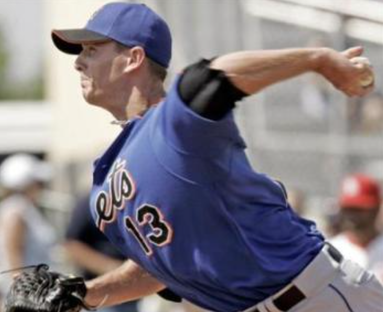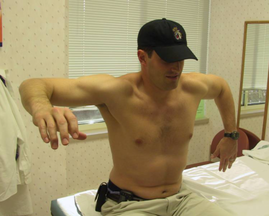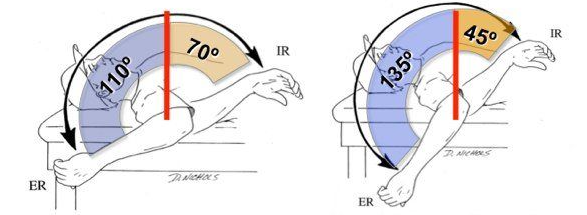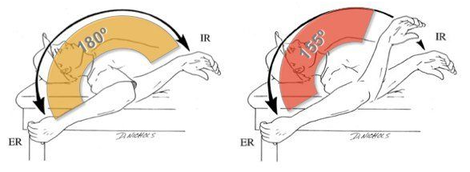
GIRD has been a hot topic in the baseball world for many years, but especially the past few. What does GIRD stand for? Glenohumeral Internal Rotation Deficit. Typically, you only hear this phrase if you see an ortho or PT about any sort of elbow or shoulder pain, but nowadays it’s not uncommon to hear it mentioned from your strength coach or athletic trainer, especially during initial assessments.
The truth behind this “GIRD” phenomenon can be confusing so I wanted to take some time and really dive in deep, and also debunk a few common myths and misconceptions while we’re at it! GIRD is actually a very common phenomenon in overhead athletes, especially throwers in sports like baseball and softball or outside hitters in volleyball. While it is common, it is seen at the most extremes in our baseball pitchers.
So, what is it? It’s a shift in our range of motion at the shoulder resulting in increased range of motion into external rotation (ER) and decreased range of motion into internal rotation (IR). Believe it or not, this shift provides BENEFIT to the thrower, because the further they are able to move into external rotation, the more acceleration and velocity they are able to produce during their throw. Here’s the kicker however – this shift in the arc of motion results in altered stresses to the joint and has been linked to labral and rotator cuff tears as well as elbow ligament injuries (Tommy John Tear).

If GIRD is both beneficial and potentially harmful what does this mean? We as doctors and physical therapists must be able to differentiate between GIRD and Pathologic GIRD (pathologic meaning problematic). The loss of IR alone is not grounds for treatment as the cause of pain, if, the loss of motion into IR is re-gained in ER. So, going off the graphic below the total arc of motion in each shoulder is 180 degrees. In this instance, the loss of internal rotation would NOT be a red flag as this is considered a NORMAL adaptation to the demands of the sport.

While there is no one specific cause of GIRD, there are 3 reasons linked to this shift in total arc of motion. First, there are capsular changes. The capsule is a soft tissue surrounding the entire shoulder (largely ligamentous), and is asked to dissipate extremely high forces on the posterior, or back, side of the shoulder while throwing. As we throw, the capsule tends to take on similar stresses as the muscle resulting in significant stiffness that changes how the shoulder rotates in the socket.
Secondly, there are bony changes at the shoulder. Most athletes began throwing at a young age and this repetitive movement alters the development of the shoulder into a position called Humeral Retroversion. This changes the resting position of the ball in the socket joint and assists with gaining this increased external rotation. Remember, this increased ER is a benefit to the thrower and these changes are completely normal and harmless to development.
This is the body’s response to be more efficient at a movement and is determined by the demands placed on it!Lastly, there are muscular changes. The act of throwing requires the muscles surrounding the shoulder and shoulder blade to act in a way that slows the shoulder down after ball release. This places a ton of tensile stress on the muscles and they go through a significant recovery and repair cycle that promotes stiffness similar to the backside capsule. Based on these three pieces that result in a loss of IR, both the capsular and muscular changes are able to be altered by your physical therapist if needed.
Pathologic GIRD is now seen in the graphic below. There is a loss of internal rotation which ALSO results in a loss of the total arc of motion from 180 degrees. If there is pain present during throwing it is very important for your physical therapist to determine the appropriate course of action here. In this instance, we work to reduce the stiffness of the capsule and muscles of the rotator cuff/scapula as these are the two causes noted above that are able to be affected through treatment.

Now that we know what GIRD is and what it is not, let me hop up on my soapbox for a minute. Pathologic GIRD is actually very UNCOMMON. In five years of working regularly with all levels of throwers from the adolescent, high school, college, and professional levels I have seen ONE case of true GIRD. In my practice it has become a term that I try to avoid even using because it is always negative. To treat it, my job is to increase mobility into internal rotation. If that is not the true cause of pain and symptoms (and usually isn’t!) I am creating MORE instability and WORSE muscular control. This then results in more stress to the shoulder or elbow, more pain, decreased velocity, and decreased control of throwing.
Remember the harmful effects of GIRD? Yeah, me too. In reality, most throwers display a limited total arc of motion with less IR than the non-throwing arm. However, it is not a loss of IR that results in this change in the arc, but a loss of ER! Unfortunately, I’ve had way too many athletes receive treatment for shoulder issues that only get more painful, reduce their ability to perform, and ultimately take longer to resolve. I will leave you with one final thought: the throwing motion is developed throughout the lifespan. There is no way to predict whose shoulder will adapt into the most humeral retroversion nor is there a way to speed up that process.
If you’re having pain with throwing at the shoulder OR elbow, that is not normal and unfortunately will not just go away. PSA for those parents trying to breed the next star pitcher: Please don’t have them lay on their back holding a weighted ball for 10 minutes to increase ER in the layback position. This will be much more harmful than beneficial. The goal is to keep throwing, keep playing, get appropriate time off, and the changes will come. If you made it to this point, thanks for sticking with me!
Throwing is one of the most primitive movements, and rotational athletes are still vastly underserved in the strength/conditioning and rehab realm which drives my passion even more! If any of this resonates with you, or your child is constantly complaining about shoulder and elbow pain, this isn’t something to wait on. Come see us and let’s fix problems well before they start limiting playing time!
And if you play baseball, make sure to check this article out on the ultimate guide to arm care!
Dr. Mike

